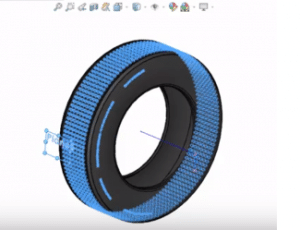Why You Should use the Automatically Load Components Lightweight Option in SOLIDWORKS
T oday we’re going to talk about what we can do to reduce the amount of data being opened by using the automatically load components lightweight option. In my first blog we talked about SOLIDWORKS large assemblies that are slow to open, slow to work with, and slow to save, and in my previous blog I had a specific focus on how the assembly was slow to open taking approximately seven minutes and thirty seconds to open.
oday we’re going to talk about what we can do to reduce the amount of data being opened by using the automatically load components lightweight option. In my first blog we talked about SOLIDWORKS large assemblies that are slow to open, slow to work with, and slow to save, and in my previous blog I had a specific focus on how the assembly was slow to open taking approximately seven minutes and thirty seconds to open.
What happens when opening an assembly in SOLIDWORKS is that information is moved from your fixed disc into RAM and the things that can affect how long it takes to open an assembly during this process are the data transfer speeds, how quickly the data can move from fixed disc into RAM, and the amount of data being opened. The first step we can take, I think, is pretty straight forward and that is we can examine our directory for unusually large part files. Each part file is going to be opened from fixed disc into RAM when you open an assembly. Therefore, if you have any unusually large part file size that’s 5 MB or more, you really want to open that part file and do what you can to reduce the overall file size, which is going to reduce the amount of data being loaded into RAM and make your assembly open more quickly.
Another step we can take to reduce the amount of data being loaded into RAM is we can check a setting in SOLIDWORKS called “automatically load components lightweight”, and really, at a higher level, we can learn how to leverage this lightweight functionality in SOLIDWORKS.
So let’s consider an example of both of those techniques to reduce the amount of data being loaded into RAM.
Let’s start off by going into Windows Explorer and examining the folder that contains the assembly and the parts that are included in the assembly. What we’re looking for here, is we’re looking to sort by size in Windows Explorer and we’re looking for parts that are unusually large (more than 5 MB) because those files really need to be examined and you need to do whatever you can to reduce the file size.
One of the first things I like to do is go into my options and go to document properties. What I’m looking for here is Image Quality and looking to see if the slider at the top is in the red zone. When you slide into the red zone you actually get a warning saying this is going to increase the file size. I like to have this from a quarter of the way to a third of the way over. I’ll usually go a little closer to the left when I’m working with large assemblies or concerned about file open time. So I’m just going to move that slider over, I’m going to hit OK and I’m going to save this part file, then close it, and then reexamine Windows Explorer.
When I went back into Windows Explorer we can see that the part file was reduced from about 9.5 MB down to about 5.5 MB which is a pretty significant reduction in file size but I still think we can do more. So I’m going to drag and drop that part file back in, and as you’ve possibly surmised, because driving up image quality increases the file size there is a correlation between the amount of detail in your file and the overall file size.
Later, I’m going to discuss how you can work with a simplified configuration but for now I’m going to look for any details that belong to this file that may not need to be included in my larger assembly and suppress those details.
In the video example below, you can see this is more detail.
Another option we have is to learn how to leverage the option for performance automatically load components lightweight. To start off go to Performance and uncheck automatically load components lightweight to turn that off, and then load the assembly in what’s called a fully resolved state.
When the assembly is open in the fully resolved state, I like to bring up the task manager, and I’m looking for the task performer for SOLIDWORKS. Next I’m going to close the assembly and reopen the exact same assembly but I’m going to make one change. I’m going to go into options, then performance, and check automatically load components lightweight.
At this point you might want to click on the help button in the corner and maybe do a search for lightweight. What you’ll find is that lightweight is an awesome mode in SOLIDWORKS where only a subset of the component is loaded, the component’s not fully resolved, it’s basically just an external shell of the component that’s loaded. The component is still solid, you can still do section views, take measurements, do mates. Ultimately what you’ll find is when you load components lightweight, you’re loading less information into RAM so the assembly should open faster.
The video example above shows a demonstration of that at the six minute mark.
Once I made these adjustments and checked the task manager I found that only 1.6 GB of RAM was being used by the SOLIDWORKS process.
Overall, what this shows is that by using lightweight, less information is being loaded from fixed disc into RAM because we’re only loading a subset of each of the part files which reduces the amount of information that needs to be loaded into RAM.
I hope you found this SOLIDWORKS large assemblies tip helpful. In part four of this blog series, I’ll be going over more best practices when working with SOLIDWORKS large assemblies. Stay tuned!
Reminder: When working with slow assemblies, make sure you reference this checklist to optimize your performance.
Related Articles
Large Assemblies and How to Make them Faster in SOLIDWORKS (Part 1)
Help! My SOLIDWORKS Large Assembly is Slow to Open
SOLIDWORKS Frequently Asked Questions: Top 10 Tips and Tricks of 2017
About the Author
 Toby Schnaars began using the SOLIDWORKS Software on the ’98 plus release, in October of 1998. He began working for Prism Engineering (now Fisher Unitech) as an instructor and tech support engineer in 2001. He has fielded over 10,000 tech support cases and been the head instructor for over 200 SOLIDWORKS training classes. Toby is a regular presenter at users groups, technical summits, and SOLIDWORKS world. In 2003, in Orlando, FL, Toby won first place in SOLIDWORKS MODEL MANIA a modeling contest based on speed and accuracy. Toby hosts a free monthly webinar called “Toby’s Tech Talk” where you can tune in and get more tips and tricks on the SOLIDWORKS software.
Toby Schnaars began using the SOLIDWORKS Software on the ’98 plus release, in October of 1998. He began working for Prism Engineering (now Fisher Unitech) as an instructor and tech support engineer in 2001. He has fielded over 10,000 tech support cases and been the head instructor for over 200 SOLIDWORKS training classes. Toby is a regular presenter at users groups, technical summits, and SOLIDWORKS world. In 2003, in Orlando, FL, Toby won first place in SOLIDWORKS MODEL MANIA a modeling contest based on speed and accuracy. Toby hosts a free monthly webinar called “Toby’s Tech Talk” where you can tune in and get more tips and tricks on the SOLIDWORKS software.

 Blog
Blog